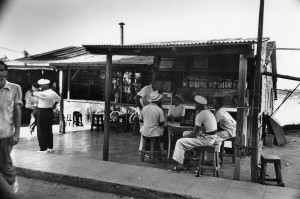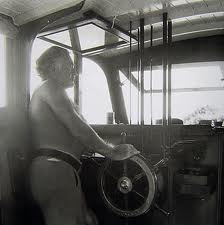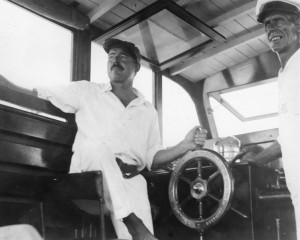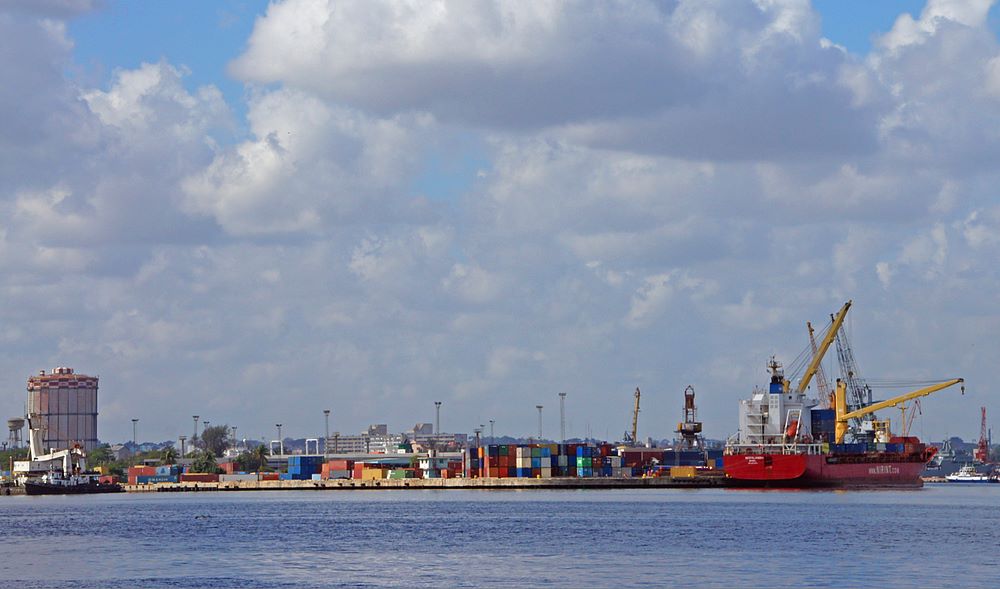ERNEST HEMINGWAY’S CUBA .
Cayo Romano, in the Jardines del Rey, is a charming place , with thousands of flamingos and large sand dunes in the embankments , with swaying coconut palms and grapes, is one of the scenarios of repeated marine excursions writer .
In the Mouth of Cojimar , East of Havana , was always the yacht El Pilar and eternal pattern ( captain) , Cuban fisherman Gregorio Fuentes, who found in Ernest Hemingway ( 1899-1961 ) , an inspiration to write this fascinating novel was ” the Old Man and the Sea.” It was precisely in Cojimar where famous novelist met in 1928 to Gregorio Fuentes ( son of Lanzarote in Spain , where he was born on July 11, 1897 , and Cojíímar in Havana , where he spent most of his life) . But it was not until 10 years after Fuentes became the standard yacht Pilar, made of mahogany and oak, with a length of 11.86 meters and 3.65 meters sleeve .
The trio formed Ernest Hemingway , Gregory and Pilar sailed actual scenarios from another writer’s novel , ‘ Islands in the Stream ‘ .
How many times from Cojimar American writer Ernest Hemingway forays into this paradise known as Cuba North Cayería Romano ? Incursions remained ignored, unknown , unstudied until today , and have a relationship with the work and life of the author of the Old and the sea in the Greater Antilles , over more than three decades.
The writer Enrique Cirules , who reveals these secrets, has been devoted to study the presence of Hemingway in Cuba ; his adventures and experiences in remote and idyllic archipelago of northern Camagüey.
Cirules tells us that Hemingway took to the fabulous Havana since 1929 , when he made his second stop in Havana , this time for nearly two months. Around that time Hemingway met one of the most magnificent and unpredictable women of the time , with whom he held strong and scandalous love affairs. These experiences allowed Hemingway form some female characters , in works like ” The Short Happy Life of Francis Macomber ” and the novel ” To Have or Have Not” , published in 1937.
Cirules also reveals that the myth Hemingway in Cuba not only began when the author of ” Farewell to Arms ” began to take over streets , plazas, bars, pubs and restaurants , hotels and piers Havana ; but since 1930 , when he began to conduct marine expeditions whose destinations were the mythical Romano Key ; first with yacht Anita , and his sidekick , Joe smuggler Russell, owner of Joe Slopy Key West ; after a two-masted schooner , owned by a wealthy family in Havana ; and from 1934 , with yacht Pilar .
These continuous voyages to the Romano during the thirties , allowed Hemingway related to extensive coastal region that from a very early age. Were places that Hemingway began visiting again and again , were (and still are) sites of charm, with thousands of flamingos and large sand dunes in the embankments , with swaying coconut palms and sea grapes .
After his tours of the Keys, Hemingway left the coves and inlets of Romano and penetrated the spacious bay of Nuevitas, cast anchor at the pier of El Guincho and staying in one of the lodges that were at the seashore .
Buildings were built with precious wood , which had balconies and terraces, waxed floors , and rooms with windows overlooking the rumors of the sea, in the lee of the famous tavern Augustine Eye. There he could drink and eat all marine delicacies before leaving on the train of the morning in search of the mythical Santa Maria del Puerto del Principe; City crooked, cobbled , with many churches and convents and plazas streets.
Usual, then , that Hemingway and his cronies visited very early that old manor villa with its colonial houses , colonnades varied interiors , French tiles overhangs , and huge jars in the cozy flowery patios.
After returning back to the pier El Guincho , the old wooden docks , the stone streets that began on the same embankment , in the shade of the coconut palms and grapes, in view of the colonial port warehouses built with lime and coral rocks , to the small town of San Fernando de Nuevitas it up the hill , among the greenery of the vegetation, to crown the hill where an ancient church was yellow ; two church towers, built by a Catalan master pieces .
It was in the port of Nuevitas, on pier El Guincho on the embankments of Sabinal fall (in those cozy accommodations, pubs, taverns , hotels and places of the world) that the writer came in contact with one of the most fascinating sites Caribbean. Here, in this marine region, when started World War II , Hemingway began with a group of friends and cronies , one of the most extraordinary adventures that any writer has made in the twentieth century: chasing German submarines aboard a yacht recreation , on the cliffs of Romano, for nearly two years, between 1942 and 1943.
Enrique Cirules us reconstructs the background in which Hemingway was inspired to write ‘ Islands in the Stream ‘ the passionate pursuit of a group of Germans between keys, islands , low , channels and chutes central Cuba submarines. Cirules also speaks on war operations in the Bahamas Channel , reveals the existence of a third German submarine sunk off the coast of America during World War II .
The fight with this submarine, three miles from Faro Maternillos , you inspired Hemingway to write the final part of his magnificent novel. All these elements contribute to a deeper understanding of the personality of Hemingway.
Besides these aspects , shown myths and legends surrounding the town of Versailles ( coastal city founded in the late nineteenth century by French emigrants ) in the easternmost area of Cayo Romano , both Hemingway knew site ; are also fishermen of the region, even those who tried to negotiate with the novelist an old pirate map , to induce Hemingway to search for lost treasures.
In these stories, never tracked, are essential aspects that Ernest Hemingway returned years later to write the most autobiographical of his novels : Islands in the Stream .
For their research, the vision contains Cirules Hemingway had fishermen , turtle , migrants, ruffians , travelers and navigators, and especially the bartenders Cove El Guincho , who for many years contacted the author of The Old and sea.
Augustine ‘s famous Tavern ‘ One-Eyed ‘ , which often are present landfall Hemingway ; delineations that were realized in a strange and fascinating lodging that stretched its balconies and terraces towards the sea ; regenteado by a woman who knew all the “Colombian” ; The splendor of the Black Cat , the finest seafood restaurant in the area, the hotel Filgueras , ‘s feasting and revelry , the passage of sea captains , Navy sailors , gamblers, and crooks , adventurers and sailors.
They are the mystery and charm of La Gloria City and Palm City ( cities in American and German , founded in the early twentieth century in northern Camagüey plain ) , in the days when Hemingway conducted its military operations in the costs of these fabulous archipelago, with the largest hunting and fishing in the Caribbean, wild horses, feral , deer, and huge flocks of flamingos and herons, and always close and fierce presence of sharks.
Through a beautiful and captivating narrative, Cirules makes us imagine the torpedoed ships, sunken submarines, between passions and adventures, with the mythical universal profile of American writers .
These elements are present in the life and work of the great American writer, where reveals Cirules, constitute a large enrichment narrative universe that Hemingway addressed in the most splendid of his novels : ‘ Island in the Stream ‘ written in 1947 , that he never gave his editors .
Lazaro Najarro / InternetPhotos / www.thecubanhistory.com
The Cuban History , Hollywood.
Arnoldo Varona , Editor.
LA CUBA DE ERNEST HEMINGWAY.
Cayo Romano, en los Jardines del Rey, es un sitio de encanto, con miles de flamencos y grandes dunas arenosas en los ribazos, llenos de cocoteros y uvas caletas, es uno de los escenarios de las reiteradas excursiones marinas del escritor.
En la Boca de Cojímar, en el Este de La Habana, siempre estuvo el yate El Pilar y su eterno patrón (capitán), el pescador cubano Gregorio Fuentes, en quien encontró Ernest Hemingway (1899-1961), una inspiración para escribir esa fascinante novela que fue “El Viejo y el Mar”. Precisamente fue en Cojímar donde famoso novelista conoció, en 1928 a Gregorio Fuentes (hijo de Lanzarote, en España, donde nació el 11 de Julio de 1897, y de Cojímar, en La Habana, donde pasó la mayor parte de su vida). Pero no fue hasta 10 años después que Fuentes se convirtió en el patrón del yate Pilar, fabricado de caoba y roble, con una eslora de 11.86 metros y manga de 3.65 metros.
El trío que formaron Ernest Hemingway, Gregorio y el Pilar navegaron por los escenarios reales de otra novela del escritor, ‘Islas en el Golfo’.
¿Cuántas veces desde Cojímar inicio escritor norteamericano Ernest Hemingway incursiones hacia ese paraíso conocido en el norte de Cuba como Cayería de Romano? Incursiones que permanecían ignoradas, desconocidas, no estudiados hasta hoy, y que tienen una relación con la obra y la vida del autor del Viejo y el mar en la mayor de las Antillas, a lo largo de más de tres décadas.
El escritor Enrique Cirules, quien revela estos secretos, se ha dedicado a estudiar la presencia de Hemingway en Cuba; sus aventuras y experiencias en el remoto y paradisíaco archipiélago de la zona norte de Camagüey.
Cirules nos narra que Hemingway se aficionó a la fabulosa Habana desde 1929, cuando realizó su segunda escala en la capital cubana, esta vez por espacio de casi dos meses. Por esos días Hemingway conoció a una de las mujeres más esplendorosas e imprevisibles de la época, con las que sostuvo intensos y escandalosos amores. Estas experiencias le permitieron a Hemingway conformar algunos personajes femeninos, en obras como “La breve vida feliz de Francis Macomber” y en la novela “Tener o no tener”, editada en 1937.
Cirules nos revela además que el mito Hemingway en Cuba no sólo se inició cuando el autor de “Adiós a las armas” comenzó a adueñarse de calles, plazas, bares, cantinas y restaurantes, hoteles y embarcaderos de la capital cubana; sino a partir de 1930, cuando empezó a realizar expediciones marinas cuyos destinos eran la mítica cayería de Romano; primero con el yate Anita, y su compinche, el contrabandista Joe Rusell, dueño del Slopy Joe de Key West; después en una goleta de dos palos, propiedad de una familia adinerada de La Habana; y a partir de 1934, con el yate Pilar.
Estas continuas navegaciones hacia la cayería de Romano, durante la década del treinta, le permitieron a Hemingway relacionarse con aquella extensa región costera desde una época muy temprana. Fueron parajes que Hemingway comenzó a visitar una y otra vez, eran (y aún lo son) sitios de encanto, con miles de flamencos y grandes dunas arenosas en los ribazos, llenos de cocoteros y uvas caletas.
Luego de sus recorridos por los cayos, Hemingway dejaba las ensenadas y caletas de Romano y penetraba en la espaciosa bahía de Nuevitas, echaba el ancla en el embarcadero de El Guincho y se alojaba en alguno de los hospedajes que se encontraban a la orilla del mar.
Eran edificaciones construidas con maderas preciosas, que poseían balcones y terrazas, pisos encerados, y habitaciones con ventanales que daban a los rumores de la mar, a sotavento de la afamada taberna de Agustín el Tuerto. Allí podía beber y comer de todas las exquisiteces marinas, antes de partir en el tren del alba en busca de la mítica Santa Maria del Puerto del Príncipe; ciudad de calles torcidas, adoquinadas, con tantas iglesias y plazas y antiguos conventos.
Era usual, por entonces, que Hemingway y sus compinches recorrieran muy de mañana aquella vieja villa señorial, con sus caserones coloniales, de variadas columnatas interiores, aleros de tejas francesas, y enormes tinajones en los acogedores patios floridos.
Después volvían de nuevo al embarcadero de El Guincho, a los viejos muelles de madera, a las calles de piedras que comenzaban sobre el mismo ribazo, a la sombra de los cocoteros y uvas caletas, a la vista de los almacenes coloniales del puerto, construidos con cales y rocas coralinas, a la pequeña ciudad de San Fernando de Nuevitas que ascendía por la colina, entre los verdores de la vegetación, hasta coronar esa elevación donde se encontraba una antigua iglesia amarilla; iglesia de dos torres, construida a retazos por un maestro catalán.
Fue en el puerto de Nuevitas, en el embarcadero de El Guincho, sobre los ribazos de cayo Sabinal (en aquellos acogedores hospedajes, cantinas, tabernas, hoteles y sitios de mundo) que el escritor entró en contacto con uno de los sitios más fascinantes del Caribe. Allí, en aquella comarca marina, cuando se inició la Segunda Guerra Mundial, Hemingway emprendió, con un grupo de amigos y compinches, una de las más insólitas aventuras que escritor alguno haya realizado en el siglo XX: perseguir submarinos alemanes a bordo de un yate de recreo, sobre los cantiles de Romano, por espacio de casi dos años, entre 1942 y 1943.
Enrique Cirules nos reconstruye los antecedentes en los que se inspiró Hemingway para escribir en ‘Islas en el golfo’ esa apasionada persecución de un grupo de submarinos alemanes por entre cayos, islas, bajos, canales y canalizos de la región central de Cuba. Cirules también nos habla sobre las operaciones de guerra en el canal de las Bahamas, nos revela la existencia de un tercer submarino alemán hundido en aguas de América durante la Segunda Guerra Mundial.
El combate con este submarino, a tres millas de Faro Maternillos, le sirvió de inspiración a Hemingway para escribir la parte final de su magnifica novela. Todos estos elementos contribuyen a una comprensión más profunda de la personalidad de Hemingway.
Además de estos aspectos, aparecen los mitos y leyendas que rodeaban a la villa de Versalles (ciudad costera fundada a fines del siglo XIX por emigrantes franceses) en la zona más oriental de cayo Romano, sitio que tanto Hemingway conocía; están también, los pescadores de la comarca, incluso los que trataron de negociar con el novelista un antiguo mapa pirata, para inducir a Hemingway a la búsqueda de tesoros perdidos.
En estas historias, nunca antes rastreadas, se encuentran aspectos esenciales que Ernest Hemingway retomó años más tarde para escribir la más autobiográfica de sus novelas: Islas en el golfo.
Por sus investigaciones, Cirules contiene la visión que sobre Hemingway poseían los pescadores, tortugueros, emigrantes, rufianes, viajeros y navegantes, y sobre todo los taberneros de la ensenada de El Guincho, que durante muchos años entraron en contacto con el autor de El viejo y el mar.
Están presentes la famosa taberna de Agustín ‘el Tuerto’, a la que a menudo Hemingway recalaba; las evocaciones que se realizaban en un extraño y fascinante hospedaje que extendía sus balcones y terrazas hacia el mar; regenteado por una mujer a la que todos conocían por la «colombiana»; el esplendor de El Gato Negro, el más exquisito restaurante marino de la comarca, el hotel de Filgueras, sitio de festines y jolgorios, al paso de capitanes de navíos, marineros de la Armada, jugadores y fulleros, aventureros y navegantes.
Están el misterio y encanto de La Gloria City y Palm City (ciudades de norteamericanos y alemanes, fundadas a principio de siglo XX en el norte de la llanura camagüeyana), en los días en que Hemingway realizaba sus operaciones de guerra en las costas de este fabuloso archipiélago, con el mayor coto de caza y pesca del Caribe, caballos salvajes, jíbaros, venados, y enormes bandadas de flamencos y garzas, y la siempre cercana y feroz presencia de los tiburones.
A través de una hermosa y cautivante narración, Cirules nos hace imaginar los barcos torpedeados, submarinos hundidos, entre pasiones y aventuras, con el perfil mítico del más universal de los escritores estadounidenses.
Estos elementos, presentes en la vida y la obra del gran escritor norteamericano, que nos revela Enrique Cirules, constituyen un amplio enriquecimiento al universo narrativo que Hemingway abordó en la más espléndida de sus novelas: ‘Island in the Stream’ escrita en 1947, y que nunca entregó a sus editores .
Lazaro Najarro/InternetPhotos/www.thecubanhistory.com
The Cuban History, Hollywood.
Arnoldo Varona, Editor.









